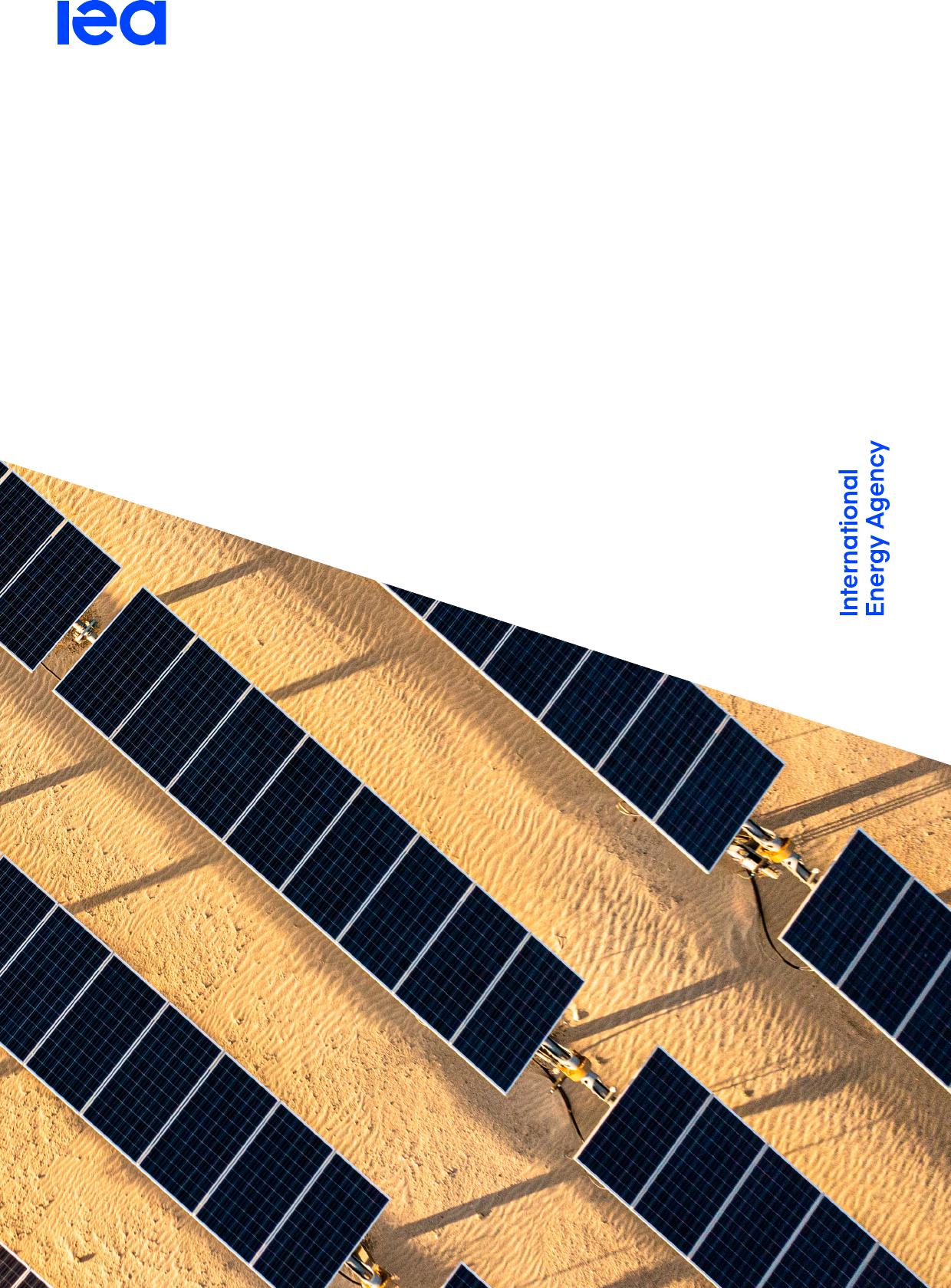RenewableEnergyOpportunitiesforMauritaniaINTERNATIONALENERGYAGENCYTheIEAexaminestheIEAmemberIEAassociationfullspectrumcountries:countries:ofenergyissuesincludingoil,gasandAustraliaArgentinacoalsupplyandAustriaBrazildemand,renewableBelgiumChinaenergytechnologies,CanadaEgyptelectricitymarkets,CzechRepublicIndiaenergyefficiency,DenmarkIndonesiaaccesstoenergy,EstoniaKenyademandsideFinlandMoroccomanagementandFranceSenegalmuchmore.ThroughGermanySingaporeitswork,theIEAGreeceSouthAfricaadvocatespoliciesthatHungaryThailandwillenhancetheIrelandUkrainereliability,affordabilityItalyandsustainabilityofJapanenergyinitsKorea31membercountries,Lithuania13associationLuxembourgcountriesandbeyond.MexicoNetherlandsThispublicationandanyNewZealandmapincludedhereinareNorwaywithoutprejudicetothePolandstatusoforsovereigntyoverPortugalanyterritory,totheSlovakRepublicdelimitationofinternationalSpainfrontiersandboundariesandSwedentothenameofanyterritory,Switzerlandcityorarea.RepublicofTürkiyeUnitedKingdomUnitedStatesTheEuropeanCommissionalsoparticipatesintheworkoftheIEASource:IEA.InternationalEnergyAgencyWebsite:www.iea.orgRenewableenergyopportunitiesforMauritaniaAbstractAbstractMauritaniahashigh-qualitywindandsolarresourceswhoselarge-scaledevelopmentcouldhavecatalyticeffectsinsupportingthecountrytodeliveruniversalelectricityaccesstoitscitizensandachieveitsvisionforsustainableeconomicdevelopment.Renewablesdeploymentwouldbenefitmining–thelargestindustryinthecountry–whichiscurrentlyreliantondieselandheavyfueloilforitsoperations.Aswitchtorenewableenergyinthesectorcouldlowercosts,reduceemissions,increaseefficiencyandimproveenergysecurityinthecountry.Thereisalsopotentialtofurtherelectrifyenergyusesinmining.Thegovernmenthasannouncedvariousexport-orientedprojectstoproducerenewablehydrogen,ammoniaand/orhydrogen-reducediron.Anchoringdemandonforeignofftakerswouldcontributesignificantlytode-risktheseprojectsandgeneratethestablerevenuestreamneededtomobiliseinvestorsatthenecessaryscale.Byattractingsignificantamountsofcapital,suchlarge-scaleprojectscouldenableatransformationofthepowersectorandspursustainableeconomicdevelopmentandgrowth,butrobustandtransparentpoliciesandregulatoryframeworksareneeded.ThisnewIEAreport–thefirstfocusingonMauritania–exploresthepotentialbenefitstoMauritaniaofdevelopingitsrenewableenergyoptionsandincludesananalysisofthewaterrequirementsofhydrogenandthepotentialforexpandingpotablewateravailabilitythroughseawaterdesalination.PAGE3IEA.CCBY4.0.RenewableenergyopportunitiesforMauritaniaAcknowledgementsAcknowledgements,contributorsandcreditsThisstudywaspreparedbytheRenewableEnergyDivision(RED)andtheDivisionforEurope,MiddleEast,AfricaandLatinAmerica(EMAL)oftheInternationalEnergyAgency(IEA).ThestudywasdesignedanddirectedbyPaoloFrankl,HeadoftheRenewableEnergyDivision.Theanalysisandproductionofthereportwereledandco-ordinatedbyIlkkaHannulaandRitaMadeira.TheworkbenefittedfromstrategicguidancebyKeisukeSadamori,DirectorofEnergyMarketsandSecurity.TheleadauthorsofthereportwereIlkkaHannula,RitaMadeira,ElisaAsmelash,TrevorCriswell,MiikaTommila,GaiaGuadagniniandYoungsunOm.OtherIEAcolleagueswhocontributedtothisworkinclude(inalphabeticalorder):BrianMotherway,ChristophWinkler,FrancescoPavan,JoséMiguelBermudezMenendez,KeithEverhart,MartinKueppers,NadimAbillama,RebeccaGaghen,SimonRichardandUweRemme.ThisworkwassupportedbytheCleanEnergyTransitionsProgramme,theIEA’sflagshipinitiativetotransformtheworld’senergysystemtoachieveasecureandsustainablefutureforall.TheIEAwouldalsoliketothankthefollowingseniorgovernmentofficialsandexpertswhoreviewedandprovidedfeedbacktothereport:CédricPhilibert(Institutfrançaisdesrelationsinternationales)DeanBialek(CWP)DolfGielenWorldBankHeribBlancoJabriIbrahim(High-LevelClimateChampions)LehbibKhroumbaly(MinistryofOil,EnergyandMinesofMauritania)LouisBecker(CWP)MamadouAmadouKane(MinistryofOil,EnergyandMinesofMauritania)MargaretMutschler(CWP)NoevanHulst(IPHE)RichardKiplagat(AfricaPractice)ThierryLepercq(HyDeal)ZuzanaDobrotkova(WorldBank)ThanksalsototheIEACommunicationsandDigitalOffice(CDO)fortheirhelpinproducingthepublication,especiallytoPoeliBojorquez,AstridDumond,ClaraValloisandThereseWalsh.WethankKristineDouadforcopyeditingofthemanuscript.PAGE4IEA.CCBY4.0.RenewableenergyopportunitiesforMauritaniaTableofcontentsTableofcontentsExecutivesummary..................................................................................................................6Chapter1.OverviewofMauritania’senergysystem............................................................9Countryoverview....................................................................................................................9Energysupplyanddemand..................................................................................................10CO₂emissionsfromtheenergysector.................................................................................12Mauritania’spowersector.....................................................................................................13Overviewofenergypolicy.....................................................................................................17Chapter2.Renewablesformining.......................................................................................19Extractiveindustries..............................................................................................................19Currentenergyuse...............................................................................................................22Potentialforrenewables.......................................................................................................23Chapter3.Exportopportunitiesfromrenewables.............................................................29Shippingammoniatoglobalmarkets....................................................................................33Exportinghydrogen-reducedirontoEurope.........................................................................34PipelininghydrogentoEurope..............................................................................................34Evaluatingdifferentpathways...............................................................................................36Chapter4.Waterrequirementsofrenewablehydrogen....................................................39Seawaterdesalinationasasolution.....................................................................................41Environmentalimpactofdesalinationplants........................................................................42WatersituationinMauritania................................................................................................43Nextsteps...............................................................................................................................45Annex.......................................................................................................................................46Explanatorynotes.................................................................................................................46Abbreviationsandacronyms.................................................................................................46Unitsofmeasurement...........................................................................................................47PAGE5IEA.CCBY4.0.RenewableenergyopportunitiesforMauritaniaExecutivesummaryExecutivesummaryMauritania’stremendousrenewableenergypotentialoffersseveralpossibilitiesforacceleratedeconomicdevelopmentinthecountry.SolarPVresourcesformthecoreofthispotential,withMauritania’slowestsolarirradiationmeasurementsonparwithsouthernEurope’shighest.Furthermore,itsonshorewindresourceincoastalareasenablesoffshorelevelperformancebutatalowercost.Deployingtheseresourcesatscaletogeneratelow-costrenewableelectricityandhydrogenthroughelectrolysiscouldthereforeattractcatalyticinvestmentsandaccelerateMauritania’senergysystemtransformationbyclosingelectricityaccessgaps,spurringcleanandsustainabledevelopmentandrevampingthepowersector.DeployingrenewableenergyatscalecouldfirsthelpMauritaniadeliveruniversalelectricityaccess.Withayoungandfast-expandingpopulation,halfofwhichliveinurbanareas,thecountryhasexperiencedeconomicgrowthinthepasttwodecades.Althoughelectricityaccesshasmorethandoubledfrom22%in2001to48%in2022,challengesremain(particularlytoextenduniversalenergyaccesstolargeswathesofnomadicruralpopulations),andattractingaffordablecapitaltoexpandenergysectorinfrastructurewillbecriticalforMauritaniatoachieveitsdevelopmentgoals.Withapopulationofnearly5million,withroughlyhalflackingaccesstopower,providingelectricityconnectionsforallremainsatopgovernmentpriority.Renewablescanalsoimproveminingoperationssignificantly.MiningalreadymakesupaconsiderableportionofMauritania’seconomyandisitslargestindustrysubsector.In2021,itaccountedfor24%ofthecountry’sGDPandin2022itgenerated71%ofitstotalexportincome.Mauritaniaisthecontinent’ssecondlargestexporterofironoreafterSouthAfrica,butitcurrentlyhaslittletonovalue-additionactivitiesinthemineralsupplychain.Asminingoperationsareenergy-intensiveandpredominantlyfossilfuel-based,raisingefficiencyinthisareatocurtailenergyusecouldcutoverallcostsaswellasCO₂emissions.DeployingsolarPVandwindpowerplantscandirectlyreducetheamountofimporteddieselandheavyfueloilconsumedbythegeneratorsthatrunelectricallypoweredminingequipment,loweringcostsandraisingenergysecurityintheminingsector.However,theextentofsuchsavingswouldbecloselylinkedwiththecostofcapitalforrenewableenergyprojects,whichinemergingeconomiescanbetwotothreetimeshigherthaninadvancednationsandcansetthebankabilitybarforprojectdevelopmentmuchhigher.Inthelongerterm,movingtowardshighervalue-additionactivitiesintheminingsupplychaincouldprovideimportantPAGE6IEA.CCBY4.0.RenewableenergyopportunitiesforMauritaniaExecutivesummaryopportunitiesforMauritaniaandboostitseconomicgrowthmoresignificantly,forinstancebyenablingtheexportofdomesticallyproducedhydrogendirectreducediron.Mauritaniacurrentlyhasthelargestpipelineofrenewablehydrogenprojectsinsub-SaharanAfricaby2030.Thecountry’shigh-qualityrenewableresourcesandvastlandareaavailableforprojectdevelopmentmakeitapotentiallycompetitiveproducerofrenewables-basedhydrogen.Infact,itcouldbeproducingrenewablehydrogenatacostjustoverUSD2/kgby2030.Successfuldevelopmentofannouncedprojectswillrelyonforeignofftakerstoanchordemandandprovidethestablerevenuestreamneededtomobiliseinvestorsatthenecessaryscale.Buttherealtransformationaleffectofsuchprojectswilldependonleveragingsignificantinflowsofforeigncurrencyandtechnologicalcapacitytodeliverdomesticbenefitsandacceleratedevelopment.Mauritaniahasthreemajoroptionstodevelopitsrenewableenergypotentialforexports.Onepathwayentailsshippinghydrogentoglobalmarketsintheformofammonia.Despitethehighcostsassociatedwithconvertinghydrogentoammonia,theoverallseaboundsupplycostislowerforammoniathanforliquidhydrogen,makingammoniathelikelychoicefortransportinghydrogenoverlongdistances–atleastduringthisdecade.ThesecondpathwayinvolvesMauritaniacouplingitsexistingironoreminingwithrenewablehydrogentoproducedirectreducedironforexporttoEurope.Thecountrycurrentlyexportofironorewasaround13Mtin2022andgeneratedaroundUSD1.3billionofrevenue.DirectreducedironcouldenabletheexportofmorerefinedproductthatfurtherincreasesMauritania’srevenues,contributestothecreationofhighlyskilledjobsandstimulatesthedomesticeconomy.ThethirdoptionistotransporthydrogentoEuropethroughapipelineconnectingMauritaniatoSpain.ThiswouldgiveMauritaniaacompetitiveadvantageoverotherpotentialrenewablehydrogenexportersoverseas,whichwouldneedtorelyonshippingtoreachEuropeanmarkets.However,itsfeasibilitywouldhingeonmobilisingsignificantupfrontinvestmentandco-ordinatingallthevariousentitiesandstakeholdersinvolved,andwouldrequireconsiderabletimeforimplementation.Deployingrenewablesforhydrogenproductioncouldbethestartingpointofwiderpowersystemtransformation.WhileMauritania’sinstalledpowergenerationcapacitytotalledlessthan1GWin2022,upto16GWofrenewablecapacitycouldberequiredby2030tosupporttheproductionofhydrogen,ammoniaand/ordirectreducediron.Furthermore,oversizingpowergenerationcapacityneededforhydrogenproductiontoprovidealsoelectricityforotherpurposescouldbepivotal,especiallyifafiscalframeworkwereinplacetoallocatepartoftherevenuestoexpandingand“greening”thepowersector.PAGE7IEA.CCBY4.0.RenewableenergyopportunitiesforMauritaniaExecutivesummaryHowever,connectinglocationswithsurplusgenerationcapacitytodistantdemandcentreswouldrequirethemobilisationofenoughcapitaltoexpandandstrengthenthegridinsuburbanareasandnearminesandindustries,includingtowithstandincreasedvariabilityofgenerationfromsolarandwind.Plus,toachievethekeypolicyanddevelopmentobjectiveofuniversalelectricityaccess,significantinvestmentsinmini-gridsandoff-gridsolutionswillbeneededtosupplypowertoremoteruralareaswheregridexpansionisnoteconomicallyviable.Renewablehydrogenproductionalsorequiressignificantvolumesofpurifiedwater,whichcanbeeconomicallyproducedtodaybyseawaterdesalination.Upto13millionm3ofpurifiedwatercouldbeneededin2030.Today’slarge-scaledesalinationplantscansupplythisquantityforaroundUSD1/m3,representingjustasmallpercentageoftheproductioncostofhydrogen.Similartopowergeneration,desalinationplantscouldalsobeoversizedtosupplyexcesswatertothepopulationforpotableuse,especiallyinwater-stressedruralareas,andforagriculturetoenhancefoodsecurity.Whilethecostofcapitalremainshighinmostofsub-SaharanAfrica,anchoringinvestmentsinforeignofftakecanhelpde-risklarge-scaleprojectsanddecreasecurrencyrisks.Mobilisingconcessionalcapitalwouldalsolikelyberequiredtofurtherde-risksuchprojects,particularlyintheirdevelopmentphase,andtostimulateprivatesectorappetitetoattractthenecessarycapital.Butultimately,Mauritania’sparticipationinlow-emissionshydrogentradingwilldependonglobaldevelopmentsincertificationstandards,marketdemandandthenumberofoff-takerswillingtopayapremiumforlow-emissionsfeedstocks.Currentlyonly17%ofexportprojectsplannedworldwidefor2030havepotentialoff-takers,soclearersignalsbypotentialimporterswillbeneededtoenhancethebankabilityofsuchprojects.ForMauritaniatopursuethesepathwaystoacceleratedsustainabledevelopment,unprecedentedco-ordinatedactionfromthegovernment,donors,privatepartnersanddevelopmentinstitutionsisneeded.Althoughsuchlarge-scaleprojectsaredifficulttostructureandimplement,theyofferMauritaniatheopportunitytoattractinvestmentintheinfrastructurethatwillunderpinitseconomicdevelopmentandgrowth.However,robustregulatoryframeworksthatencouragetransparentresourcemanagementandgoodgovernancewillbecriticaltounlockthispotential.Strongcommitmentfromthedonoranddevelopmentcommunitywillbekeytosupporttheseefforts,whileprivatesectorcapitalandexpertisewillbeinstrumentaltomovefromconcepttoimplementation.AndwhilethesepathwayscouldbecriticalenablersforMauritaniatosignificantlyadvancethepursuitofitssustainabledevelopmentgoalssuchasuniversalaccesstoelectricityandeconomicgrowth,theirtrueappealliesintheopportunitytobuildamoreprosperousandbrighterfutureforthecitizensofMauritaniaanditsfuturegenerations.PAGE8IEA.CCBY4.0.RenewableenergyopportunitiesforMauritaniaOverviewofMauritania’senergysystemChapter1.OverviewofMauritania’senergysystemCountryoverviewTheIslamicRepublicofMauritania(hereafterMauritania)inNorthwestAfricaspansaterritoryof1030000km2,withatotalpopulationofaround5million.Mostcitizensliveinthesouth,as90%ofthecountryisdesertorsemi-desert.Thecountry’spopulationisyoungandgrowingquickly(2.6%annualgrowthin2022),withmorethanhalflivinginurbanareas,whichcontinuetogrowrapidly,particularlyonthecoastandinthesouth.EconomicgrowthhasliftedMauritaniaintotheranksoflower‐middle‐incomecountries.In2022,itsGDPwasUSD10.4billion,twiceashighasin2008,andGDPpercapitaUSD2191.Thecountry’seconomyisdominatedbyservices(44%),followedbytheprimarysector(20%)andindustry(36%).Theminingindustry,whichrepresentedclosetoone-quarteroftotalGDPin2021,isakeydriveroftheeconomy,followedbyfisheriesandagriculture.Mauritania’seconomicgrowthreliesheavilyoncommodityexports(mainlyironore,gold,copperandfishandcrustaceans),whichexposesittoglobaldemandandpricefluctuationsforthesecommodities.Mauritania’seconomyhasbeengrowinginrealGDPtermsthankstoincreasedhouseholdconsumptionandinvestments,whileitsfiscaldeficitisexpectedtoshrinkandaverageinflationtofallto5%by2025.However,thecountryisexposedtodownsiderisksresultingfromsustainedhighoilandfoodprices,combinedwithlowexportcommoditypricesandconstrainedfiscalresources,regionalpoliticalinsecurityandextremeweatherevents.Thegovernmentisincreasinglyunderpressuretooptimisepublicexpendituresandalleviatethedistortingimpactsofaneconomythatreliesheavilyonexportrevenuesfrommining.Tothisend,thegovernmenthascreatedanAgencyforthePromotionofInvestmentsinMauritania,withthecoremissionofattractingandsupportinginvestmentsinarangeofsectors,includingrenewableenergy.Nevertheless,severalconstraintscontinuetodiscourageprivateinvestment,includingthehighcostofcapitallinkedtotheelevatedlevelofrisk(bothactualandperceived),limitationsonthequantityandqualityofinformationoninvestments,andlowmarketcompetition.PAGE9IEA.CCBY4.0.RenewableenergyopportunitiesforMauritaniaOverviewofMauritania’senergysystemEnergysupplyanddemandDataonenergysupplyanddemandarefragmentedandlackingindetailbutaresufficienttoidentifythebroadpictureandgeneraltrends.In2021,totalenergysupply(TES)amountedto80PJ,orroughly17GJpercapita.Mauritania’senergysupplyisgeneratedalmostentirelyfromimportedoilandtraditionallocalbiomass(firewoodandcharcoal).Thecountry’stransportandminingoperationsrelyonoil,whichisalsothemainenergysourceforelectricitygeneration.Totalfinalconsumption(TFC)was54PJ,orcloseto13GJpercapita(Figure1.1).TransportaccountedforalmosthalfofTFC,followedbyresidentialbuildings(35%)andindustry(11%).Otherusessuchasagriculture,fishingandservicesrepresented8%.AlthoughTFChasincreasedroughlytwo-and-a-halftimessince2000,per-capitaconsumptionremainsverylowbyinternationalcomparison,asglobalaverageTFCpercapita(54GJ)isfourtimeshigherthaninMauritania,andelectricityusepercapita(around34500kWh)isalmosttentimeshigher.Nevertheless,TFCpercapitaremainsalignedwiththesub-SaharanAfrica(SSA)average(excludingSouthAfrica)(16GJ).Figure1.1Mauritania´sTFCbysectorandpercapita,2000-2021PJ6016GJpercapita451230815400Buildings-residentialTransportIndustryOthersTFCpercapita(rightaxis)IEA.CCBY4.0.AlargepartofMauritania’spopulation,especiallyinruralareas,livesinpoorconditionswithoutfullaccesstomodernenergysupplies.AccordingtoIEA2022data,lessthanhalfofthepopulationhasaccesstoelectricityandonly48%ofcitizenshaveaccesstocleancooking.Replacingtheuseofunsustainablyharvestedtraditionalbiomassandincreasingelectricityaccessarethereforeamongthegovernment’skeydevelopmentpriorities.PAGE10IEA.CCBY4.0.RenewableenergyopportunitiesforMauritaniaOverviewofMauritania’senergysystemBox.1.1CleancookingToday,nearlyone-thirdofpeoplearoundtheworldstilluserudimentarymethodstocooktheirmeals.Theyburncoal,firewoodandanimaldungasfuel,breathinginhazardousfumesdaily.Bringingcleancookingtohouseholdsindevelopingeconomiesiscentraltotheprovisionofmodern,secureandsustainableenergy,andkeytospurdevelopment,improvehealthandreducegenderdisparities.WhileinAsiaandLatinAmericathenumberofpeoplewithoutaccesstocleancookinghasbeendeclining,insub-SaharanAfricaitcontinuestogrow.Althoughaccesstomodernenergyhasimproved,thisabsolutegrowthresultslargelyfrompopulationexpansionoutpacinggains.Theshareofpopulationwithaccesstocleancookingincreasedfrom29%in2000to48%in2021,butthenumberofpeoplewithoutaccessrosefrom1.9millionin2000to2.4millionin2021.CleancookingaccessinMauritaniabysegment(left)andoverallpopulation(right),2000-2021100%580%Population(million)460%340%220%10%2005201020152020-201020212000NationalUrbanRural2000WithaccessWithoutaccessIEA.CCBY4.0.Source:IEA(2023),AVisionforCleanCookingAccessforAll.Majorbarrierstocleancookingforallcontinuetobeaffordabilityandfinancialsupportforhouseholdstocoverupfrontstovecostsand,insomecases,ongoingfuelcosts.Afullscale-upofinternationalcapitalinjectionsandconcessionalfinancingwouldcorrectthisrapidly,withjustrelativelymodestfundsrequiredannually.AccordingtoIEAanalysis,USD8billionwouldbeneededeachyeartoachieveuniversalaccessby2030globally;inSSA,aroundhalfofthatamountwouldberequired.Innovativefinancingsolutionscouldmakecleancookingamoreattractiveinvestmentopportunity,asdemonstratedbysuccessstoriesinIndia,ChinaandIndonesia,wheretheshareofpeoplewithoutaccesswashalvedduringthelastdecade.Whileculturaltraditionslinkedtothepreparationofdishesremainanimportantdeterrent,governmentscanpromotecleancookingthroughsensitisationcampaigns.PAGE11IEA.CCBY4.0.RenewableenergyopportunitiesforMauritaniaOverviewofMauritania’senergysystemCO₂emissionsfromtheenergysectorEnergy-relatedCO₂emissionscomelargelyfromoiluse.In2021,theyamountedto4.3Mt(Figure1.2),approximately0.01%oftotalglobalCO₂emissions.Per-capitaemissionsarealmost1t,roughlyequaltotheAfricanaverage(0.9t),butonlyone-quarteroftheworldaverage.Forinstance,China’sareseventimeshigher,andUSper-capitaemissionsexceedMauritania’sbyaroundthirteentimes.TransportaccountedforalmosthalfofMauritania’stotalCO₂emissionsin2021andelectricitygenerationforone-fifth,withemissionsincreasing3.4timesfrom2000to2021.In2019,CO₂emissionsmadeuplessthanone-thirdofMauritania’stotalGHGemissions(14Mt).Infact,thecountry’smainGHGsources(two-thirdsofthetotalin2018)aremethaneandnitrousoxidefromits20millionruminants(sheep,goatsandcattle).Figure1.2Mauritania´sCO₂emissionsfromfuelcombustionbysector,2000-20215MtCO₂4200520102015Others3BuildingsIEA.CCBY4.0.2Electricity1Industry2000Transport2021IEA.CCBY4.0.Regardingitsclimatepolicytargetsfor2030,MauritaniaaimstoreduceGHGemissionsby11%(unconditional)toasmuchas92%(conditionalonanestimatedUSD30+billionininternationalfinancing)fromthebusiness-as-usuallevel.ThesetargetsareincludedinMauritania´supdated(October2021)NationallyDeterminedContributionsundertheUNFCCCParisAgreement.Theunconditional2030targetsincludeattaining13GWofrenewablepowercapacity(includingthecapacitytoproducehydrogenforexports)andincreasingtheshareofrenewableenergyinitselectricitysupplyto50%.PAGE12RenewableenergyopportunitiesforMauritaniaOverviewofMauritania’senergysystemMauritania’spowersectorElectricsystemoverviewMauritania’selectricitygridiscomposedofoneinterconnectedsystem;large,isolatedgrids(alsoconsideredon-gridsystems);anddieselandhybridmini-grids.Thestate-ownedutilitySociétéMauritanienned'Electricité(SOMELEC)generatesandsupplieselectricityformostoftheterritory,exceptforthecountry’sthreelargeminingcompanies,whichusetheirowngeneratorstopowertheiroperations(seeChapter3),andforafewmini-gridoperatorsinisolatedlocations.AccordingtoIEAdata,electricitygenerationin2021amountedto1.7TWh,primarilyfromoil(89%),followedbywind(6%)andsolarPV(5%);installedcapacitytotalled490MW.Industrialandcommercialconsumersareresponsiblefornearly65%offinalelectricitydemand.Thecountry’selectricitysupplyalsoincludeshydropowerimportsfromtheManantali,FelouandGouinaHydroPowerPlants(HPPs)onMali’sSenegalRiver,withimportstotalling188GWhin2021.TheseHPPsareoverseenbytheOrganisationfortheDevelopmentoftheSenegalRiver(OMVS),whosemembernationsincludeGuinea,Mali,MauritaniaandSenegal.Foundedin1972,theOMVSmanagestheSenegalRiverbasin’sagriculture,irrigation,energy,transportationanddrinkingwatersupply,anditsafeguardsthebasinenvironmentandcontinuestoplayamajorroleintheregion’shydropowerdevelopment.In2022,SOMELECreportedhaving490MWofgeneratingcapacity,mostlyfromthermalinstallationsthatrunonheavyfueloil(HFO).However,asMauritaniaissettobeginproducingnaturalgasinthefirstquarterof2024,SOMELECplanstoaddseveralhundredmegawattsmorecapacitypoweredbynationallyproducedgasby2030,andtoswitchfromoiltogasatthe180-MWNouakchottplant,thelargestinitsfleet.SwitchingtodomesticgasfromimportedoilinelectricitygenerationwouldbringMauritaniaeconomic,environmentalandenergysecuritybenefits.SOMELECisalsoincreasingitsfocusonsolarandwindpowertogeneratecleanandaffordableelectricity.Itsfleetcurrentlyhas30MWofwindand83MWofsolarcapacity(Figure1.3),withthe100MWBoulenouarwindpowerparkawaitingconnection.ThegovernmentorSOMELECownandoperatetheprojects,withsomeruralinstallationsbeingbuiltbyinternationalcompanies.Thewindcapacityfactorreached44%in2021,whilethesolarcapacityfactorisbelow20%.Thesignificantwindandsolarpowerprojectsrecentlyannouncedbyinternationaldevelopersandthegovernmentinconnectionwiththeproductionofhydrogenviaelectrolysis(seeChapter3)mayalsohastenandexpandadoptionofthesePAGE13IEA.CCBY4.0.RenewableenergyopportunitiesforMauritaniaOverviewofMauritania’senergysystemtechnologiesfordomesticpowerproduction.SOMELECthereforeenvisionsrolesforbothdomesticnaturalgas,andsolarandwindpowerinthefutureasthecountry’selectricitysectorexpands.Figure1.3Mauritania’sinstalledpowergenerationbytechnology,2022IEA.CCBY4.0.IEA.CCBY4.0.Note:Includedinwindpowergenerationisthe102-MWBoulenouarWindFarm,whichisawaitinggridconnection.Source:IEAanalysisbasedondatafromSOMELECandIRENA.The2022ElectricityLawInDecember2022,Mauritaniaadoptedanewelectricitylawtoimprovetheperformanceofthepowersectorandfosteranenablingenvironmenttoattractprivatesectorinvestment.The2022ElectricityLawopenstheelectricitysectortoindependentproducersandsplitsthestate-ownedelectricitymonopolySOMELECintofourentities:aholdingcompany,andseparatesubsidiariesforgenerationandtransmission;distributionandmarketing;andruralelectrification.However,SOMELECremainsresponsibleforelectricitygeneration,transmission,distributionandmarketingforcustomersservedbythenationalgrid.IndependentpowerproducersawardedgenerationlicencesmustenterintoagreementswithaSOMELECorotherauthoriseduserbutreceiveprioritydispatchinthesystem.Inaddition,industrialcustomersmayalsosignsupplyagreementsforsystemsover30kWprovidingon-sitepower.Whilethelawaimstoimprovetheelectricitysector’sfinancialhealth,italsocontainsprovisionstoaccelerateruralelectrificationandgivesconnectionandnetworkpreferencetorenewableenergyandhybridgeneratingsolutionstothatend.Italsostatesthatmini-gridswillbeusedinsteadofnationalgridexpansioniftheEnergyMinistry’scost-benefitanalysissupportsit.TheEnergyMinistrywilltendermini-gridprojectsandsubsidisethemasneeded,withsubsidiesbeingpaidPAGE14RenewableenergyopportunitiesforMauritaniaOverviewofMauritania’senergysystemoutofaspecificRuralElectrificationFundestablishedunderthelaw.TheFundwillbefinancedfromseveralsources,includingthestatebudget,alevyonelectricitygeneration,contributionsfrominternationaldevelopmentpartnersandcarboncreditsforGHGreductions.AccesstoelectricityAlthoughMauritania’selectricitysupplyhasincreasedinpercentagepointssince2000,itsinsufficiencyremainsoneofthemainobstaclestothecountry'seconomicandsocialdevelopment.Whiletheshareofpeoplewithaccesstoelectricityrosefrom22%in2000to48%in2021,theactualnumberofpeoplewithoutaccessincreasedslightlyfrom2.1millionin2000to2.4millionin2021(Figure1.4).Perhapscounterintuitively,thenumberofpeoplelackingelectricityaccessincreasedfrom2000to2021inurbanareas(from0.5millionto1million)anddeclinedinruralareas(from1.6millionto1.4million).Nevertheless,in2022electricityaccessinurbanareaswas60%andinruralareas32%,whichstillrepresentsamajordifference.Expansioninruralareassurpassedtheurbanratesimplybecauseurbanpopulationgrowthoutpacedgainsinelectricityaccess.Sinceurbanpopulationgrowthexceedsruralvaluesbyaroundfivetimes,electricityaccessisgrowingmoreslowlyinurbanareas.Figure1.4Accessbysegment(left)andoverallpopulation(right),2000-2021.100%580%Population(million)460%340%220%10%20052010201520200201020212000NationalUrbanRural2000WithaccessWithoutaccessIEA.CCBY4.0.Thegovernmentplanstomeetits2030electricityaccessobjectivebyexpandingthepowergrid,increasingelectricitygenerationcapacityandimplementingaruralelectrificationprogramme.Althoughthegovernment’spriorityoptiontoincreaseelectricitysuppliesrapidlyistoaddgas-firedcapacity,implementationdependscruciallyontheavailabilityofgasfromoffshoregasprojectsandthedevelopmentofinfrastructuresuchaspipelinestotransportthegastoshore.PAGE15IEA.CCBY4.0.RenewableenergyopportunitiesforMauritaniaOverviewofMauritania’senergysystemThegovernmentalsoplanstoprovideelectricityaccesstoalllocalitiesofmorethan500inhabitantsbybothexpandingtransmissionlinesandofferingdecentralisedmini-gridsolutionstopermanentlyisolatedareas.Itisespeciallychallengingtosupplypowertoruralcommunitiesoflessthan500inhabitantsbecausetheyaredispersednomadicpopulationsinremoteareaswhereroadconnectionsarepoor,soconnectingthemthroughtraditionalgridinfrastructurewouldnotbecost-effective.TransmissionandgridexpansionMauritania’selectricitytransmissionsystemcoversthesouth-eastregionofthecountryandisinterconnectedwiththeOMVSsystem.Nouakchott,thecapital,isconnectedtothesystembya225kVlineextendingtoDagana,Senegal.Largegridextensionprojectshavebeendesignedtoconnectmainurbancentrestothe180MWNouakchottpowerplantortotheSenegalesesystemOMVScoveringtheborderingsouthsideofthecountry.TransmissionexpansionincludestwomainHVlinesbetweenNouakchottandNouadhiboucompletedin2023andanadditionallinebetweenNouakchottandZouerate,whichisunderconstruction.Theseplansstemfromthe2012ProductionandTransmissionMasterPlan,whichfocusesonexpandingtransmissionanddistributionlinestoultimatelyinterconnectallexistingsystems.The2012MasterPlanaimedtoincreasedomesticelectricproductioncapacity,includemorerenewableresourcesintheenergymix,installadditionaloff-gridpoweranddeveloptransmissioninterconnectionswithborderingcountries.Expansionplansannouncedinearly2023includeupgradingcircuitcapacitybetweenthemajorcitiesofNouakchottandNouadhibou,whilealsoincreasingaccessfor12000additionalcustomerssurroundingthecity.PlannedexpansionsalsoincludelinkswiththeneighbouringcountriesofMaliandSenegal,whichwouldhelpsupplysouthernMauritania.Box1.2AttractinginvestmenttogridinfrastructureScalinguprenewablepowergenerationcapacity,particularlybeyondcaptivesystems,willrequiremajorinvestmentsintransmissionanddistributioninfrastructuretoimprovesystemreliability,expandaccessandfacilitatetheintegrationofvariablerenewableenergysources.However,annualinvestmentsinAfrica’sgridsystemsgrewonly5%between2019and2022.Largerinvestmentsareneedednotonlytolaynewlinesandincreasegriddensitytosupportgreatergeneration,buttoupgradeandenhanceexistinginfrastructure.Acrossmostofthecontinent,state-ownedutilitiesholdthemonopolyontransmissionanddistribution,somuchoftheinvestmentsallottedtoelectricityPAGE16IEA.CCBY4.0.RenewableenergyopportunitiesforMauritaniaOverviewofMauritania’senergysystemsystemupgradesareexpectedtobedonethroughpubliccapital.Thiscanbeproblematicasutilities’financialsituationsworsenduetopoorpaymentcollectionrates,illegalconnections,costincreases(includingthecostofcapital),operationalproblemsandsupplychainconstraintsthatreducecashflowsanddriveupdebt.Furthermore,mostAfricanutilitiesreporthighsystemlossesintherangeof10-19%,withanaverageof15%acrossthecontinentin2020–morethandoubletheglobalaverageof7%.Privatesectorfinancingcouldthereforebeintegraltodeveloptransmissionanddistributionlines,althoughitislikelytobelimitedtocountriesthathaverelativelywell-developedpowersystemsandastableregulatoryenvironment.Avarietyofapproachesforinvestmentsofthiskindareusedglobally.Governmentscanpreparebyreformingtheircountry’stariffstructureandauthorisingtheuseofconcessionagreementsorotherregulatorycarveoutsforprivatesectorinvestmentandownership,aswellasbyintroducingauctionsandcompetitivetenders.Source:IEA(2023),FinancingCleanEnergyinAfrica.OverviewofenergypolicyIEA.CCBY4.0.Mauritaniahassignificantrenewableenergypotential,particularlysolarandwind,aswellasmajoroffshorenaturalgasprospects.Thegovernmentisencouragingthedevelopmentofalltypesofenergyresourcesforbothexportandthedomesticmarket,andinthepastcoupleofyearshasannouncedseveralprojectsworthmorethanUSD78billiontoproducerenewablehydrogen(i.e.,hydrogenmadefromrenewableenergyresourcesviaelectrolysis).ThegovernmentisalsopursuingnaturalgasdevelopmentwiththeGovernmentofSenegalthroughtheGreaterTortueAhmeyim(GTA)offshoreLNGproject,withgasproductionexpectedtocommenceinearly2024.TotakegreateradvantageofMauritania’sabundantbutlargelyunexploitedenergyresources,thegovernmenthassetthreekeyenergypolicyobjectivescentredaroundachievinguniversalaccesstoelectricityby2030.Bydevelopinggas,solarandwindresources,thegovernmentaimstoenhanceenergysecurity,becomeareliablesupplierofgasandrenewableenergy,anduseaffordableandabundantdomesticenergyresourcestostimulateeconomicandsocialdevelopment.Tomeettheseenergypolicyobjectives,thegovernmentaimstoincreaseenergysupplieswithathree-phaseplan.Thegoalofthefirstphase,from2022to2025,istodevelopoffshorenaturalgasresourcesinco-operationwithmajorprivatesectorpartners.Phasetwo(2025-2030)involvesexpandinggasprojectsandintroducingdecarbonisationtechnologies–especiallyinironoreandgoldmining(currentlyfuelledbyoil)–andbuildinglarge-scalerenewableenergyprojects,asPAGE17RenewableenergyopportunitiesforMauritaniaOverviewofMauritania’senergysystemswitchingawayfromoilinelectricitygenerationwouldreducecostsandCO₂emissions.Inthethirdphase,from2030onwards,extensiveproductioncapacityforrenewablehydrogenandammoniaaretobedeveloped.TheGovernmentofMauritaniaisthuspositioningthecountryasapotentialproducerofnear-zeroemissionssteel,capitalisingonitsrenewablehydrogenplansandextensiveironoreresources.Thegovernmentalsoforeseesopportunitiesfordomesticallyproducedrenewablehydrogentosupportthecreationofnewindustrysectors,suchasfertiliserproduction.TogetherwithEgypt,Kenya,NamibiaandSouthAfrica,MauritaniaisafoundingmemberoftheAfricaGreenHydrogenAlliance(AGHA).ThepurposeofAGHAistointensifycollaborationandsuperchargedevelopmentofgreenhydrogenprojectsontheAfricancontinent.Box1.3Mauritania’snaturalgasdevelopmentsMauritaniaisonthecuspofbecominganewgasproducerandexporterfollowingrecentoffshorediscoveriesoftheGTA,developedjointlywithSenegalandtheBirAllahgasfield,currentlyatthedevelopmentstage.LikeotherAfricancountrieswithlargenaturalgasprojects(e.g.MozambiqueandEgypt),suchdevelopmentscouldboostMauritania’sdevelopmentsignificantlybyincreasingitsnationalrevenuesandsupportingindustrialisation.WhilegascurrentlymeetsaroundhalfofNorthAfrica’senergyneeds,insub-SaharanAfricatheshareofnaturalgasintheenergymixisamere5%.However,theconsiderableresourcediscoveriesofthepastdecadeprovideanopportunityfornaturalgastoplayalargerroleintheregion’senergysystems.Aroundone-quarterofthe7000bcmofnaturalgasresourcesdiscoveredinthepastdecadeinAfricahasbeenapprovedfordevelopment,includingtheGTA.Iftheseprojectsareallcompletedontime,theywillprovidearound70bcmofgasperyearby2030.CumulativeCO₂emissionsfromusingthesegasresourcesoverthenext30yearswouldbearound10Gt–equivalenttoroughlyfourmonthsofglobalenergysectoremissionstoday.Africa’sshareofcumulativeenergy-relatedCO₂emissionsfrom1890totodayisaround3%,andaddingthecumulativelifetimeemissionsfromburningthisgastoAfrica’scurrentcontributionwouldraisethissharetojustunder3.5%.However,thereisariskthatnewprojectswithlongleadtimescouldstruggletorecovertheirupfrontcostsiftheworldsuccessfullyreducesgasdemandtoachievenetzeroemissionsbymid-century.Note:Forfurtherinformation,seeIEA(2022),AfricaEnergyOutlook2022.Source:IEA(2023),FinancingCleanEnergyinAfrica.PAGE18IEA.CCBY4.0.RenewableenergyopportunitiesforMauritaniaRenewablesforminingChapter2.RenewablesforminingExtractiveindustriesMineralsareMauritania’slargesttradedcommodity,accountingfor56%oftotalexportincomein2022.Preciousmetalsaresecond-largestat15%,representedentirelybygoldoreminingandextraction.Theremaining29%isfromtheexportoffish-derivedproducts(fresh/frozenfish,fishoilandfishflour)andotherproducts(textiles,machines,etc.).Figure2.1Mauritania’sexportsbyproduct,2022(left)andGDPsharesbysectorandactivity,2021(right)IEA.CCBY4.0.IEA.CCBY4.0.Sources:ANSADE(2023),IndicedelaProducetionIndustrielle(left-hand);ANSADE(2023),Mauritaniadataportal(right-hand).Takentogether,extractiveindustriesrepresented24%ofthecountry’sGDPin2021.Ironoreisbyfarthelargestprimarymineralproductbyexportvalue(90%),followedbycopper(9%).Ironminesarealllocatedinthenorthernpartofthecountry,whilecopperoreandgoldminesareinthecentral-westernregion.MiningisalsoMauritania’slargestindustrialsector,withmorethan60nationalandinternationalcompaniesoperatinginextractiveindustries.Themaincompaniesare:TheNationalIndustrialandMiningCompany(SNIM)–ironoremining,exploitingdepositsinthenorthernpartofthecountry.MauritaniaCopperMines(MCM)–coppermining,operatinginthewesternpartofthecountry(intheInchiriregion)andalsoinvolvedinironandgoldproduction.ItisasubsidiaryofFirstQuantumMineralsLtdinCanada.PAGE19RenewableenergyopportunitiesforMauritaniaRenewablesforminingTasiastMauritanieLimitedS.A.–goldmining,operatingagoldmineinthenorthwesternpartofthecountry(intheDakhlet-Nouadhibouregion).ThecompanyisasubsidiaryofKinrossGoldCorporation(Canada).Table2.1Selectedironore,copperoreandgoldminingsitesinMauritaniaSiteMineCompanyTypeProduction/yrGuelbElSNIMIronore(magnetite)5MtTiris-ZemmourRheinSNIMDistrictM’HaoudatSNIMIronore(hematite)8MtZouerateSystemSNIMironmineTazaditSNIMKediad'IdjilRouessamountain(partoftheZouerateF’DerickSystemironmine)InchiriregionGuelbFirstQuantumCopperore13313tinMoghrein(Canada)Gold2022NorthwestofFirstQuantumGoldMauritaniaTasiast(Canada)Gold1tonneinNorthwestof2022MauritaniaTijiritKinrossGold15tonnes(Canada)(2022,followingAyaGoldandexpansion)SilverFeasibilitystudyongoingNotes:M’HaoudatandKediad'IdjilarepartoftheZouerateSystemironmine.Tazadit,RouessaandF’DerickarepartoftheKediad'Idjilmountain.Mauritaniaisthesecond-largestexporterofironoreontheAfricancontinent(justafterSouthAfrica)andthe11thlargestexporterintheworld.Mauritania’sironoreproductionandexportstotalled12.7Mtin2022andgeneratedaroundUSD1.3billionofrevenue.Theexcavatedoreistransportedtothecoastbytrain,usingasingle-raillineof700kmfromtheZoueratregiontotheportcityofNouadhibouinthewest.Thetrainline’sannualcapacityisabout17Mt/yr.CopperoreisMauritania’ssecond-largestexportedmineral,withproductionof13313tonnesin2022generatingatotalvalueofaroundUSD133million.Thecountry’smaincopper-goldopen-pitmineisGuelbMoghrein,locatedintheInchiriregion,250kmnortheastofNouakchott.Inadditiontocopper,theminealsoproduced570000tonnesofhigh-grademagnetiteconcentrateandalmost31000ouncesofgoldin2022.Themineemploysaround1200people.PAGE20IEA.CCBY4.0.RenewableenergyopportunitiesforMauritaniaRenewablesforminingFigure2.2LocationofMauritania’sironandcopperoreminesrelativetoitselectricitytransmissionnetworkIEA.CCBY4.0.IEA.CCBY4.0.Note:Thismapiswithoutprejudicetothestatusoforsovereigntyoveranyterritory,tothedelimitationofinternationalfrontiersandboundariesandtothenameofanyterritory,cityorarea.Source:IEA(2021),CleanEnergyTransitionsintheSahel.Thecountryhasa704kmrailwaylinelinkingtheironoreminingsitesintheTirisZemmourregiontotheminingportofNouadhibou.ItalsohasaroadnetworkentirelydedicatedtoconnectingtheInchiri,Dakhlet-NouadhibouandTrarzaminingbasinstotheseaportsoftheAtlanticcoast.GoldwasdiscoveredinMauritaniaintheearly1990s,andgoldmininghasbecomeasignificantsourceofrevenue:morethanhalfamillionounces(15tonnes)wereproducedin2022withatotalvalueofUSD1billion.Goldisexcavatedfromtwomainsites,theTasiastmineandGuelbMoghrein.PAGE21RenewableenergyopportunitiesforMauritaniaRenewablesforminingTheTasiastmineisanopen-pitoperationinnorthwesternMauritania,operatedbytheCanadiancompanyKinrossGold.Itisthelargestmineinthecountry,representingover90%oftotalgoldproduction.Meanwhile,GuelbMoghreinisacopper-goldoperationoftheCanadiancompanyFirstQuantumandlocatedinnortheasternMauritania,nearthetownofAkjouit.In2022,goldproductiontotalledabout30000ounces(around1tonne).CurrentenergyuseMiningoperationsareenergy-intensiveanddependpredominantlyonfossilfuels.In2021,theglobalminingsectorproduced4-7%ofglobalCO₂emissions.Fuelsareusedmainlytooperateminingequipmentsuchashaultrucks,drills,excavatorsandloaders,whilecomminution(crushingandgrinding)oftheminedmaterialisthemainconsumerofelectricity.Inremotelocations–outsidethereachoftheelectricitygrid–powerisusuallyprovidedbydieselgenerators,addingtofueldemand.Amine’senergyrequirementsdependonthematerialbeingextractedandthetypeofmine.AllminesinMauritaniaareopen-pit,situatedoutsideofpopulatedareasandfarfromtheelectricitygrid.Extractionreliesonoff-griddieselandHFOgenerators,anddiesel-fuelledmachinesandtrucksforoperationsandtransport.AccordingtotheOfficeofNationalStatisticsofMauritania,SNIMconsumed65Mtoffueloilin2016formining.Table2.2.Estimatedtypicalenergyrequirementsperminingoperationforcopper,ironandgoldDistributionbyenduseMineralEnergyMiningdieselComminutionOtherprocessesconsumption(electricity-based)(electricity-based)Iron–hematite0.15GJ/t90%-10%0.3GJ/tIron–41%43%16%magnetiteCopper26GJ/t57%34%9%Gold370GJ/kg60%26%14%Source:Engeco(2021),MiningEnergyConsumption2021.Magnetiteandhematiteminingrequires0.15-0.3GJofenergypertonneofironore,whilecopperminingusesmuchmoreenergy,averaging26GJpertonneofPAGE22IEA.CCBY4.0.RenewableenergyopportunitiesforMauritaniaRenewablesforminingcopper.Goldminingisveryenergy-intensive,requiringaround370GJperkilogrammeofgold.Intotal,miningoperationsinMauritaniaconsumedaround5500TJofdieseland1TWhofelectricityin2022.PotentialforrenewablesRenewablesforminingIncreasingenergyefficiencyinminingoperationscanreduceenergyuse,overallcostsandCO₂emissions.Energyefficiencycanbeimprovedalongtheentireminingvaluechain,resultingfrombettermanagementofelectricitydemandandutilisationofwasteheattoimproveddataanalysis.SomeenergyefficiencyimprovementshavealreadybeenimplementedattheTasiastgoldmine,wheretheredesignofmineroadshasreducedthelengthofhauls,loweringdieselfueluseandreducingannualCO₂emissionsby10000tonnes.Furtheremissionreductionscanbeachievedbyswitchingtorenewableenergysources.Approximately40%ofthefuelconsumedbyextractiveindustriesinMauritaniaisusedtogenerateelectricityforprocessessuchascrushing,grinding,filtrationandpumping.TheseusescanbedirectlypoweredfromwindandsolarPVplantsinsteadofdieselgenerators.Benchmarkprices(Figure2.3)ofrecentlyawardedrenewableelectricityprojects–inlocationswithsolarirradiationandwindspeedssimilartoMauritania’s–havebeenintherangeofUSD15-38/MWhforutility-scalesolarPVandUSD26-41/MWhforonshorewind.ThissuggeststhatthecostofrenewableelectricityinMauritaniaisalreadywellbelowtheestimatedcostofdiesel-basedelectricitygeneration(USD80-110/MWh)andwouldleadtosignificantsavingsintheminingsector.However,actualpriceswoulddependonthespecificcharacteristicsofindividualprojectsandcouldbeinfluencedbythehighercostofcapitalforrenewableenergyprojectsdevelopedinMauritaniacomparedwithotherpartsoftheworld.Thecostofcapitalforutility-scaleenergyprojectsinAfricacanbetwotothreetimesgreaterthaninadvancedeconomiesandisoftenhigherforsmallerprojectsthathavefewercapitalproviders.PAGE23IEA.CCBY4.0.RenewableenergyopportunitiesforMauritaniaRenewablesforminingFigure2.3AwardedbidpricesforsolarPVandonshorewindinselectedlocationsvs.estimateddiesel-basedLCOEinMauritaniaIEA.CCBY4.0.Note:LCOE=levelisedcostofelectricity.Asavariableelectricitysource,solarPVgenerationneedstobemanagedtoavoidunexpectedinterruptionsinminingoperations.Initially,existingdieselgeneratorscanbeusedasaback-upelectricitysourceatnightorwhenweatherconditionsreducegenerationfromrenewables.Dependingonthesite,ahybridsolarPV&windpowerplantcanincreasethestabilityofelectricitysupplyforindustrialuses,andrenewableelectricitysharescanbefurtherenlargedbyinvestmentsinbatteryenergystoragesystems.Theminingindustryisalreadytakingthefirststepstointroducerenewablesintoitsoperations.Forinstance,in2022KinrossbegandevelopingasolarPVpowerplantatTasiastwithpowergenerationcapacityof34MWandan18MWbatterysystem.TheprojectispartofKinross’seffortstoreduceitsGHGemissionsandisexpectedtoprovideapproximately20%ofthesite’spower.Overthemine’slifetime,theTasiastsolarprojectisexpectedtoreduceemissionsbyaround530ktCO₂andfuelusebyapproximately180millionlitres.AnotherexampleistheEssakanegoldmineinBurkinaFaso,whichsourcesitspowerfromAfrica’slargesthybridengine-solarPVpowerplant.BycontrollingandoptimisingtheuseofelectricityfromsolarPVinstallationsandengines,thegoldminewasabletoreduceitsfuelconsumptionbyapproximately6millionlitresperyearanditsannualCO₂emissionsby18500tonnes.AsolarhybridpowerplantiscurrentlybeingdevelopedalsoinSouthAfricaattheVametcogoldmine.PAGE24IEA.CCBY4.0.RenewableenergyopportunitiesforMauritaniaRenewablesforminingElectrificationofminingoperationsInadditiontoelectricitygeneration,dieselisusedtorunmobileequipmentsuchashaultrucks,dozersanddrills,aswellasminingequipmentsuchashydraulicshovelsandcrushers.Electrificationofminingequipmentisalreadyunderway,andminingtruckswithelectricdrivetrainsarecommerciallyavailabletoday,offeringhigherpayloadcapacityandgreaterenergyefficiencythanconventionaldieselengines.Asanalternativetorelyingonstationarychargingofbatteries,haultruckscanbepoweredbyoverheadelectriclinesastheyusuallyfollowdesignatedpathsbetweenminingareasandoff-loadingsites.Thebenefitsofsuchcatenarysystemsarehighestwhendrivinguphill,asthisiswhenthemostenergyisrequired.Duringdownhilltravel,overheadlinescouldbeusedtorecoverbrakingenergyaselectricity.Figure2.4PotentialforrenewableelectricitytodisplacefueluseinminingoperationsIEA.CCBY4.0.Note:Efficiencyofdiesel-basedtrucks40%;efficiencyofelectrictrucks80%.Equipmentmanufacturersarealreadyofferingandtestingtruckswithelectricdrivetrains.Alargebatteryelectricminingtruckwassuccessfullydemonstratedin2022,completinga7kmcoursefullyloaded,achievingatopspeedof60km/h,andsuccessfullytravellingfor1kmona10%gradebothuphillanddownhill.KeyminingindustrycustomerssuchasBHP(theworld’slargestminingcompany),RioTintoandFreeport-McMoRan(operatoroftheworld’slargestgoldmine)supportedthedevelopmentofthisprototypetruck.PAGE25IEA.CCBY4.0.RenewableenergyopportunitiesforMauritaniaRenewablesforminingBatteryelectrictruckshavehigherefficiencyandloweroperatingcoststhandieselandhydrogentrucksthankstotheirsimplicityandsmallernumberofmechanicalcomponents.Thetimerequiredforstationarychargingofthebatteriescanbeachallenge,althoughneedsdependontheapplication.Forexample,on-boardchargingofbatteriesispossiblefromoverheadlinesonuphillclimbsandbyregeneratingbrakingenergyonthewaydown.Insomecases,whenthemineishigherthantheoffloadlocation,duringthedownhilldrivetruckscanregeneratemostoftheenergyneededtoclimbbackupthehillempty.DecarbonisingallMauritania’sminingoperationswouldrequirearound1.7TWhofrenewableelectricity(Figure2.4).Asafirststep,fossilfuelusecanbereduced60%byswitchingfromdieseltosolarPVandwindgeneratorsforelectricallypoweredprocesses.Remainingfuelusecouldbedisplacedbyelectrifyingallmobileequipment(trucksanddrills),whichwouldleadtoanadditional0.6TWhofdemandforrenewablepower.Box2.1ExtractiveIndustriesTransparencyInitiativeTheExtractiveIndustriesTransparencyInitiative(EITI)isaglobalstandardforthegoodgovernanceofoil,gasandmineralresources.The57countriescommittedtoEITIaimtostrengthenthetransparencyandaccountabilityofextractivesectormanagementbyimplementingtheEITIStandard,whichoutlinesrequirementsforEITIcountriesaswellastheEITIArticlesofAssociation.ValidatingtheEITIStandardpromotesdialogueandlearningatthecountrylevel,providingopportunitiestoidentifyandaddresschallengesrelatedtoimprovingextractivegovernance.Amongtheconditionsofthe2023EITIStandardisaprovisionontheenvironmentalimpactsoftheextractiveindustry(EITIRequirement6),whichsetsaprerequisitefordisclosinginformationonenvironmentalimpactassessments,certificationschemes,licencesandrightsgrantedtooil,gasandminingcompanies,aswellasdetailsontherolesandresponsibilitiesofrelevantgovernmentagenciesinimplementingtherulesandregulations.Includedinthisrequirementarealsotransparencyinenvironmentalmonitoringproceduresandingovernmentadministrativeandsanctioningprocesses,aswellasenvironmentalliabilities,environmentalrehabilitationandremediationprogrammes.Mauritaniajoinedtheinitiativein2007tosupporteconomicgrowthandstrengthenthecontributionofextractiverevenuestodevelopmentprojectsandpovertyreduction.Mauritania’sprioritiesincludeimprovingthesystematicdisclosure,accessibilityanduseofextractivesectordata,andfacilitatingmulti-stakeholderdialogueonextractivesectorgovernance.AccordingtotheEITIMauritaniaReportPAGE26IEA.CCBY4.0.RenewableenergyopportunitiesforMauritaniaRenewablesformining2020-2021,MauritaniahasmadesomeprogressinbecomingfamiliarwithEITIrequirementsandstandards.Forexample,SNIMhasestablishedanenvironmentalmanagementsystem(EMS)inaccordancewiththeISO14000familyofstandards,placingenvironmentalpreservationandnaturalresourcemanagementattheheartofitsbusiness.Nevertheless,thereportstillhighlightsdifficultiesinaccessingdetailedinformationaswellasinsufficientconsiderationofsocialandenvironmentalissues.Thislatterconcernisexemplifiedbytheextractiveindustry’spaymentstoMauritania’sEnvironmentalCommissionin2021,whichamountedtojust5.61%ofthesector’stotalrevenueforthatyear.Source:EITI(2023),TwentyYearsofExtractivesTransparency.PAGE27IEA.CCBY4.0.RenewableenergyopportunitiesforMauritaniaRenewablesforminingPAGE28IEA.CCBY4.0.RenewableenergyopportunitiesforMauritaniaExportopportunitiesfromrenewablesChapter3.ExportopportunitiesfromrenewablesMauritania’shigh-quality,abundantrenewableresourcesandvastamountoflandavailableforprojectdevelopmentmakeitapotentiallycompetitiveproducerofhydrogenfromrenewableenergysources.Thecountry’ssolarPVpotentialis2000-2300kWh/m2/year,withitslowestirradiationmeasurementsonparwithsouthernEurope’shighestsolarresources.Thecountry’swindenergypotentialisalsosignificantaroundcoastalareasintheNouadhibouregion,wherecapacityfactorsforonshorewindgenerationexceed50%,offeringsimilarperformancetooffshorewindbutatalowercost.Thecombinationoftheseresourceslaysasolidfoundationforlow-costproductionofhydrogenandhydrogen-basedfuelsfromrenewables.Large-scaleexportsofhydrogen-basedproductscanestablishnewlow-emissionsrevenuestreamsandkick-startotherpositivedevelopmentssuchaseconomicdiversification,improvedenergyaccessandincreasedenergysecurity.Bysecuringforeignofftake,theseprojectscouldprovidethestablerevenuestreamneededtomobiliseinvestorsatthenecessaryscaleandanopportunityfortheGovernmentofMauritaniatoleverageinflowsofhardcurrencytoacceleratesustainableeconomicdevelopment.Forexample,oversizingthepowerplantsneededtoruntheelectrolyserscouldprovidesurpluspowertomeetdomesticneeds,especiallyifafractionoftherevenueswouldbechannelled–throughfiscalpolicy–intoexpandingandenhancingthepowersystem.However,adetailedanalysisofhowthiscouldbeimplementedisbeyondthescopeofthisreport.Table3.1AnnouncedhydrogenandammoniaprojectsinMauritaniaNameofStatusLocationProjectAnnouncedAnnouncedExportprojectdeveloperrenewablesoutputorientedFeasibility8500km2inAmanstudythenorthofCWPGlobalcapacity1.7MtH₂/Yes,partlyprojectthecountry&10MtNH3of18GWwindMauritanianand12GWproductiongovernmentoutputsolarNourFeasibility5000km2inChariotwith10GW1.2MtH₂ofYes–PortofprojectstudythenorthofTotalErenproductionRotterdamthecountrycapacityPAGE29IEA.CCBY4.0.RenewableenergyopportunitiesforMauritaniaExportopportunitiesfromrenewablesNameofStatusLocationProjectAnnouncedAnnouncedExportprojectConceptdeveloperrenewablesoutputorientedNearcapitalGreencityConjuncta,capacity0.28–YesammoniaInfinity0.3MtNH3(primarilytoNouakchottPower,400MWofproductionGermany)projectUAE’s(Phase1)Masdar30GWoutputNassimConceptbp10MtNH3ofprojectproductionoutputSource:IEA(2023),HydrogenProjectsDatabase.Fourmajorprojectshavebeenannounced,whichseektoleveragetheseopportunities.Theyaretechnicallycomplex,requireconsiderableinfrastructure,significantinvestmentandarestillatearlystagesofdevelopment.TheAmanproject,oneofAfrica’slargesthydrogenprojects,islocatedinnorthwesternMauritaniaintheDakhletNouadhibouandInchiriregions.CWPsignedaframeworkagreementinMay2022toadvancedevelopmentoftheproject,whichincludestheconstructionof30GWofhybridwindandsolarcapacitytoproduce1.7Mt/yrofrenewablehydrogenoncefullycommissioned.Thefirststageoftheprojecthasascaleofaround5GWofrenewablesandistobeonlineby2029-2030.TheAmanprojecthasofferedtoboostelectrificationinMauritaniabyinvestinginadedicatedgrid-connectedpowerplant,aswellasbycontributingUSD3milliontoruralelectrificationprogrammes.Givenitsincorporationofalargedesalinationplant,theAmanprojectalsohasthepotentialtofeedintonationalwatersupplyinfrastructure.Earlyvolumesdiscussedwiththegovernmentareintheneighbourhoodof50Mm3offreshwatertosupplylocalcommunitiesandincreaseagriculturalproduction.Meanwhile,theNourProjectislocatedinnorthernMauritaniaclosetotheportofNouadhibou,oneofMauritania’smainexportports.Theprojectisbeingco-developedbyChariotEnergyandTotalErenandfeatures10GWofrenewablecapacitytoproduce1.2Mtofhydrogenperyearby2030.InApril2022,ChariotEnergysignedamemorandumofunderstandingwiththePortofRotterdamtoexporttheplant’srenewablehydrogentoEurope.Thetwopartiesagreedtoestablishthesupplychainsnecessaryforhydrogentrade,andtoworktogethertoconnectwithpotentialofftakersandsecurecontractsforspecificvolumes.TheGreenAmmoniaproject,announcedinMarch2023,isbeingdevelopedbyConjuncta(aGermanprojectdeveloper),InfinityPower(Egypt’senergyprovider),theUnitedArabEmirates’MasdarandtheGovernmentofMauritania.TheprojectislocatednearMauritania’scapitalcityandwillbedevelopedinfourphases.Thefirstphase,whichcouldstartoperatingby2028,aimstodeploy400MWtoPAGE30IEA.CCBY4.0.RenewableenergyopportunitiesforMauritaniaExportopportunitiesfromrenewablesproducearound0.3Mtofrenewableammonia.Onceallfourphasesarecomplete,landallocatedtotheprojectcouldaccommodatearound10GWofelectrolysercapacity,withafinaloutputof8Mtofrenewableammonia.SignificantvolumesareplannedtobeexportedtoGermany.IEAanalysisoftheannouncedhydrogenprojectsinAfricashowsthatMauritaniacouldbecomesub-Saharan-Africa’slargestexporteroflow-emissionshydrogenby2030,supplying35%ofthecontinent’stotalhydrogenexports.Figure3.1Levelisedcostofrenewablehydrogeninselectedpotentialexportcountriesandimportmarketsin2030IEA.CCBY4.0.IEA.CCBY4.0.Notes:Technicallifetime25years.Electrolyserefficiency69%.ElectrolyserCAPEXUSD610/kWe.AnnualOPEX3%ofCAPEX.WACC6%.Thedashedcolumnrepresentsthehigh-capital-costcaseforMauritaniaat15%WACC.WithanticipatedreductionsinthepriceofelectrolysersandofsolarPVandwind,thelevelisedcostofrenewablehydrogenwilldeclinesignificantlyfromtoday’slevels.By2030,itcoulddroptoUSD2.2/kgH2inMauritania,USD2.1/kgH2inOman,USD2.2/kgH2inAustraliaandUSD1.7/kgH2inChile.Incomparison,productioncostsnearcentralEurope’smajorindustrialhubscouldstillbearoundUSD3/kgin2030(Figure3.1).Thus,foranticipateddemandcentressuchasEuropeandJapan,theirhigherproductioncostsandmorelimitedproductionpotentialduetohighpopulationdensitiesmeanstheywillbemorereceptivetohydrogenimportsfromregionswhereproductioncostsarelower.However,productioncostsareverysensitivetothecostoffinancing,whicharetypicallyhigherindevelopingthanadvancedeconomies.Forexample,iftheweightedPAGE31RenewableenergyopportunitiesforMauritaniaExportopportunitiesfromrenewablesaveragecostofcapitalforahydrogenprojectinMauritaniawere15%insteadof6%,thelevelisedcostofhydrogenwouldjumptooverUSD4/kg.Figure3.2ThreepotentialpathwaystoleverageMauritania’srenewableenergypotentialNote:Thismapiswithoutprejudicetothestatusoforsovereigntyoveranyterritory,tothedelimitationofinternationalfrontiersIEA.CCBY4.0.andboundariesandtothenameofanyterritory,cityorarea.OftheseveralpossiblewaystodevelopMauritania’srenewableenergypotential,wediscussthreeoptions:Shippingammoniatoglobalmarkets.Mauritaniacouldconsidershippingitshydrogentoglobalmarketsintheformofammonia.Exportinghydrogen-reducedirontoEurope.MauritaniacouldcoupleitsexistingironoreminingindustrywithhydrogenreductiontoproducehotbriquettedironforexporttoEurope.PipelininghydrogentoEurope.HydrogencouldbeexportedtoEuropethroughahydrogenpipelineconnectingMauritaniatoSpain.PAGE32RenewableenergyopportunitiesforMauritaniaExportopportunitiesfromrenewablesShippingammoniatoglobalmarketsIncontrasttohydrogen,marinetransportofammoniaisalreadywelldeveloped,relyingonchemicalandsemi-refrigeratedliquefiedpetroleumgas(LPG)tankers.Althoughitisexpensivetoconverthydrogentoammonia,theoverallsupplycostbyseaislowerforammoniathanforliquidhydrogen,makingammoniathelikelyforminwhichhydrogenwillbetransportedoverlongdistances,atleastduringthisdecade.Internationaltradeofammoniaandtheinfrastructurerequiredforitsstorageandtransportarewellestablishedandtechnologicallymature,althoughsignificantcapacityexpansionswouldbeneededtofacilitategrowthininternationalhydrogentrade.Worldwide,approximately150terminalsandportscanhandleammonia,asmanycountrieswithabundantnaturalgasresourcesexportit,mainlyforuseasafertiliserfeedstock.However,Mauritanialacksbothammoniainfrastructureandammonia-relatedknowhow,sosignificantinvestmentswouldberequired,includingforportinfrastructuresuchasstoragetanks,dedicateddeepwaterjetties,exportterminalsandpipelines.Buildingnewinfrastructurecanoftenbethelengthiestpartoftheprocess,andportterminalscantakenineyearsonaveragetobuild.Figure3.3Estimatedsupplycostsofrenewableammoniafromselectedpotentialexportcountries,2030IEA.CCBY4.0.IEA.CCBY4.0.Notes:Technicallifetimeof25years.Haber-BoschsynthesiswithASUCAPEXUSD41/GJperyear.AnnualOPEX3%ofCAPEX.Haber-Boschsynthesisefficiency86%(LHV).TransportcostsareadjusteddependingonthetransportdistancetoEurope.Between2010and2020,averagemonthlyammoniapricesininternationalmarketswereintherangeofUSD250-750/t.PAGE33RenewableenergyopportunitiesforMauritaniaExportopportunitiesfromrenewablesMauritania’slevelisedproductioncostforrenewableammoniacouldreach520/tonneby2030,withthetotalsupplycostrisingtoUSD540/tonneoncethecostofshippingisconsidered.Atthislevel,Mauritaniacouldsupplyrenewableammoniaatacostthatwouldbecomparabletothehigherendofammoniamarketpricesduring2010-2020,andwellbelowtherecordlevelsofmorethanUSD1000/tonneexperiencedgloballyin2022duetonaturalgaspricehikes(Figure3.3).Exportinghydrogen-reducedirontoEuropeMauritania’sironoreproductionandexportstotalled12.7Mtin2022,generatingaroundUSD1.3billionofrevenueandhavingadecisiveimpactonMauritania’seconomy.Nevertheless,itwouldbepossibletocombineexistingminingoperationsandironoretransportinfrastructurewithrenewableenergytoenabletheexportofamorerefinedproduct,suchasdirectreducediron(DRI).Thiswouldgeneratemorelocalvalue-addedbenefitsthanexportofrawironore,whichisMauritania’scurrentbusiness.DRItechnologyusinglow-emissionshydrogeniscurrentlyatthelargeprototypestage,withmultipleprojectsannouncedinEurope.Forinstance,theHYBRIT(HydrogenBreakthroughIronmakingTechnology)demonstrationprojectproducedtheworld’sfirst“fossil-freesteel”in2020anddelivereditsfirstshipmenttoVolvoin2021.AnotherexampleisArcelorMittal’snewprojectinHamburg,aimedatindustrial-scaleproductionandtheuseofhydrogenDRIwithannualsteeloutputof100000tonnes.InMay2022,ArcelorMittalannouncedthatithadsignedanon-bindingmemorandumofunderstandingwiththeironoreminingcompanySNIMtoevaluatethepotentialtojointlydevelopapelletisationplantandDRIproductionplantinMauritania.Aprefeasibilitystudywastobecompletedinthefirsthalfof2023.Duetotheconsiderableamountofenergyrequiredtoreduceironore,largesteelimporterssuchastheEuropeanUnionandtheUnitedStatesarebeginningtoexaminethepossibilityofimportingspongeironfromregionsthathaveabundantlow-emissionsenergyresourcesandspaceforlarge-scaleprojectdevelopment.Aswithammonia,MauritaniacouldpotentiallybecomeacostcompetitiveproducerofDRIatalevelisedcostofaroundUSD400/tonneby2030.PipelininghydrogentoEuropeDuetoitslocation,MauritaniacouldtransporthydrogentoEuropeviaadirectpipelineconnectingthetwocontinents.ThiswouldgiveMauritaniaacompetitiveadvantageoverotherpotentialrenewablehydrogenexporterssuchasAustralia,ChileandOman,whichwouldallneedtorelyonshippingtoreachEuropeanmarkets.PAGE34IEA.CCBY4.0.RenewableenergyopportunitiesforMauritaniaExportopportunitiesfromrenewablesHydrogentransmissionbypipelineisamaturetechnology,withroughly4600kmofhydrogenpipelinescurrentlyinoperation,over90%ofwhichareinEuropeandtheUnitedStates.Thesenormallyclosedpipelinesystemsareownedbylargemerchanthydrogenproducersandareconcentratednearindustrialconsumercentres(suchaspetroleumrefineriesandchemicalplants).ThecostoftransportinghydrogenbypipelineisgenerallyaroundUSD0.2-0.4/kgforadistanceof1000km,assumingitisalargepipelinewithseveralgigawattsoftransportcapacity.ThedistancefromMauritaniatoSpainisroughly2500km,anditisanother2500kmtocentralEurope’smaindemandcentres.Figure3.4EstimatedsupplycostsofrenewablehydrogentoEuropefromselectedpotentialexportcountries,2030IEA.CCBY4.0.IEA.CCBY4.0.Notes:Technicallifetimeof25years.Electrolyserefficiency69%.ElectrolyserCAPEXUSD610/kWe.AnnualOPEX3%ofCAPEX.WACC6%.Transportcostsbyseacoverconversiontoammonia,shippingtoEuropeandreconversionbacktohydrogenatthedestination.Forthepipelineestimate,adistanceof5000kmisassumed(thedistancebetweenMauritaniaandCentralEurope).RealisationofthepipelinewouldenableMauritaniatosupplyhydrogentoEuropeatacostofaroundUSD3/kgH₂,whilethesupplycostofshippinghydrogenasammoniafromChile,OmanandAustraliawouldbe30-70%higherafterreconversionbacktohydrogen(Figure3.4).AfeasibilityassessmentbyrenewableenergydeveloperGaiaFutureEnergyandtheindustrialconsortiumHyDealforasubseahydrogenpipelinefromMauritaniaandMoroccotoSpainisongoing.InJune2023,thetwopartiesagreedtosupportafeasibilitystudyforconstructionofthepipeline,whichwouldcapitaliseonPAGE35RenewableenergyopportunitiesforMauritaniaExportopportunitiesfromrenewablesopportunitiescreatedbytheH₂MedPipelineconnectingSpaintoFranceandGermanyby2030.ThefirstresultsofthepipelinefeasibilitystudyaretobepresentedthisyearduringCOP28inDubai,spearheadedbytheGreenHydrogenOrganization.EvaluatingdifferentpathwaysMauritania’samplewindandsolarresourcespositionitasapotentiallycompetitiveexporterofrenewables-basedhydrogen,ammoniaanddirectreducediron.However,successinscalingupthesemarketsdependsonseveralfactorsbeyondjustrenewableresourcequality.Thepotentialpathwayshavewidelydivergentrequirements,forinstanceforinfrastructuredevelopment,marketcreation,stakeholderco-ordination,labourforcetraining,etc,whichneedtobecarefullyconsideredintheweighingofoptions.Table3.2SelectedopportunitiesandchallengesofthethreepossibledevelopmentpathwaysHydrogenAmmoniaexportsIronorepipelinereductionInfrastructuredevelopmentneedsStakeholderco-ordinationGeopoliticalissuesDemandriskandmarketflexibilityLabourforcetrainingneedsDomesticretentionofthevaluechainJobcreationTechnicalstandardreadinessTechnologyreadinesslevelScalinguphydrogendirectreducedironproductionwouldmakegooduseofthecountry’smultiplestrengths.Itcouldcapitaliseonexistingminingandironoreexportinfrastructureandexpandtomanufacturingofnear-zeroemissionsiron,therebyproducingavalue-addedexportproduct.However,technologytoproducehydrogen-baseddirectreducedironiscurrentlystillatthelargeprototypestageandfurthertechnologydevelopmentmayberequiredforitreachcommercial-scaleproduction.PAGE36IEA.CCBY4.0.RenewableenergyopportunitiesforMauritaniaExportopportunitiesfromrenewablesMeanwhile,theproductionandmarinetransportofammoniaarewelldevelopedbut,unlikewithironore,Mauritaniadoesnothavepre-existingexpertiseandknowhowforhandling,processingandexportingfuels,includingammonia.Ammoniasafetyaspectsespeciallyneedstobecarefullyaddressedinallpartsofthesupplychain.Substantialinvestmentswouldberequiredtobuildnewportinfrastructuresuchasdeepwaterjettiesandstoragetankstohandleandstoreammonia.ThepipelinetoEuropewouldpositionMauritaniaasacompetitivesupplierofrenewablehydrogen,enablingittohavelowercoststhanotheranticipatedexportersthatneedtorelyonmarinetransport.Althoughpipelinetransportofhydrogeniswelldeveloped,experienceinnaturalgastransportisnotdirectlyapplicabletohydrogenwithoutworkforcetraining.Furthermore,developingalongpipelinethatcrossesnationalbordersrequirestheovercomingofgeopoliticalbarriersandcarefulco-ordinationamongthenumerousstakeholders,includingregulatoryauthoritiesandcommunitiesaffectedbythepipeline.Thepipelinecouldberoutedthroughtheopenoceanalongthecoast,butwithaddedcomplexity.Inanycase,buildinganewpipelinemayalsobeimpededbymultiplehurdlesrelatedtoconstructionmanagement,standardsrequirements,environmentalprotectionandregulatorymodels.Figure3.5Mauritania’scurrentinstalledcapacity,andcapacityrequiredforhydrogenproductionby2030IEA.CCBY4.0.IEA.CCBY4.0.Sources:IEAanalysisbasedondatafromSOMELECandIRENA(2023),RenewableCapacityStatistics2023.PAGE37RenewableenergyopportunitiesforMauritaniaExportopportunitiesfromrenewablesDespiterepresentingverydifferentapproachestodevelopingMauritania’srenewableenergypotential,allthepathwaysrelyonmassivedeploymentofwindandsolarcapacity.Indeed,upto16GWofrenewableenergyproductioncouldbeneededby2030tosupportMauritania’sannouncedhydrogenprojects,implyingamassiveincreasefromtoday’sinstalledpowergenerationcapacityoflessthan1GW.PAGE38IEA.CCBY4.0.RenewableenergyopportunitiesforMauritaniaWaterrequirementsofrenewablehydrogenChapter4.WaterrequirementsofrenewablehydrogenAround10litresofwaterisneededtoproduce1kgofhydrogenthroughelectrolysis.Inadditiontoservingasafeedstock,watermightalsobeneededforcooling.Threemaintypesofcoolingsystemscanbeapplied,eachassociatedwithverydifferentwaterrequirements.Aircoolingdoesnotconsumeanywater,asbyproductheatfromelectrolysisistransferredtoambientairmovedbyfans.Aircoolingoffersflexibilityinsiteselection,asplantsarenotdependentonamajorbodyofwater.However,alargesurfaceareaforheatexchangersandfansthatmoveconsiderableamountsofairisrequired.Also,efficiencyislow,especiallyinhotandaridclimates,ascoolingtemperaturesarelimitedbytheambientdry-bulbtemperature.Evaporativecoolingsystemsdischargeheatthroughcontrolledevaporationinacoolingtower.Giventhehighamountofenergyrequiredtoevaporatewater,relativelysmallvolumeisneeded.However,waterthatisusedforevaporativecoolingcannotbereturnedtoitssourcebecauseitislostasvapourintheprocess.Netwaterconsumptioncanvarybetween30and80litres/kgH₂dependingonthedesignofthecoolingsystemandclimaticconditions.Once-throughcoolingoperatesonliquidwaterthatcanbereturnedtoitssourceafteruse.Heatfromelectrolysisistransferredtothewater,increasingitstemperaturebyabout10°C.Relativelylargevolumeofwaterisneeded–between1500and3000litresperkilogrammeofhydrogen,whichispossibleonlywhenelectrolysersarelocatedclosetoanabundantwatersource.Asidefromfilteringoutforeignmaterials,notreatmentoftherawwaterisneededforcoolingpurposes.However,regularmaintenanceisrequiredtopreventcorrosion,scalingandfoulinginthecoolingsystem.PAGE39IEA.CCBY4.0.RenewableenergyopportunitiesforMauritaniaWaterrequirementsofrenewablehydrogenFigure4.1Waterrequirementsforelectrolytichydrogenproduction,bycoolingmethodIEA.CCBY4.0.IEA.CCBY4.0.Iftheproducedhydrogenisnotusedonsite,itislikelypressurisedtoreduceitsvolumeforstorageandtransport.Thepressurisationcanbeachievedusingmulti-stagecompressorswithintercooling,furtherincreasingthewaterneedsassociatedwithlarge-scalehydrogenproduction.Intermsofwaterquality,electrolysersrequireultrapurewater,whichneedsadditionaldeionisationtoreachtheconductivityrangeof0.1to1μSv/cm.Coolingwaterdoesnotneedtobeaspureaselectrolyserfeedwater,butitmustbetreatedforevaporativecoolingpurposestominimisecorrosionandpreventfoulinginthesystem.Incoastalareas,once-throughcoolingwithseawatercanbeagoodalternativetoevaporativecooling,asitdoesnotrequiredesalinatedwater.Severallarge-scalepowerplantsusethiscoolingmethod.Innovativeconfigurationscanhelpdecreasewaterrequirements.Somecompaniesareexploringthepotentialtousewasteheatfromelectrolysersinmembranedistillationdesalinationunitstoproducecleanwater,reducingtheneedforcoolingwaterforelectrolysis.Wasteheatcanalsobeusedfordistrictheating,aselectrolysersproducearound45-65MJofbyproductheatperkilogrammeofhydrogen,butthishasratherlimitedpotentialinhotclimates.InanenvironmentsuchasMauritania’s,evaporativecoolingisthemostsuitablechoicebecauseitworksbetterinhotanddryairwhileconsumingrelativelylittlewater.However,dustandsandmaygettrappedinsidethecoolingtowerandreducethesystem’sefficiency.Installingsandtrapfilterstoremoveheavyparticlesfromtheaircanthuskeepanevaporativecoolingsystemcleanandefficient.Infact,Omanrecentlycommissioned20evaporativecoolerswithsandtrapstoair-conditionanindustrialwarehouse.Similarconfigurationmightbeconsideredforelectrolysercoolingaswell.PAGE40RenewableenergyopportunitiesforMauritaniaWaterrequirementsofrenewablehydrogenSeawaterdesalinationasasolutionWatersupplypossibilitiesforelectrolytichydrogenproductionvarysignificantlydependingongeographicandclimaticconditions.Potentialproductionsiteswithfavourablesolarresourcesareofteninaridregions,meaningthatlimitedsurfaceandgroundwaterresourcesarelikelytobeclaimedalready,largelyforagriculturalanddrinkingwateruses.Interesttowardsseawaterdesalinationforhydrogenproductioninwater-stressedareashasthusbeenincreasing.Thermalandmembrane-basedmethodsarethetwomaincommerciallyavailabledesalinationtechnologies.Untilthelate1990s,desalinatedwaterwasproducedmostlythroughthermalevaporation.However,owingtoimprovementsinmembranetechnologyandassociatedcostreductions,membranefiltrationnowaccountsfortwo-thirdsoftheworld'sdesalinationcapacity.Reverseosmosisisthemostwidelyusedmembranetechnology.Itinvolvespushingsalinewaterathighpressurethroughasemipermeablemembranethatfiltersdissolvedchemicalsandbiologicalspeciesoutofthewater.Reverseosmosisplantstypicallyproduceabout40%desalinatedwaterperlitreofseawater,sotheinitialintakeishigherthantheamountofuseablewaterproduced,butsinceseawaterisplentiful,thehigh-intakeeffectisinsignificant.Themostwidelyusedthermaldesalinationtechnologiesaremultistageflashdistillation(MSF)andmulti-effectdistillation(MED),whereinpurewaterisproducedusingmultiplestagesofthermalevaporationfollowedbycondensation.Figure4.2GlobalcumulativecapacitybydesalinationtechnologyIEA.CCBY4.0.Note:IEAanalysisbasedondatafromDesalData.com,MediaAnalyticsLtd.IEA.CCBY4.0.PAGE41RenewableenergyopportunitiesforMauritaniaWaterrequirementsofrenewablehydrogenSeawaterdesalinationcapacityhasexpandedsignificantlyinrecentdecades,especiallyindry,high-incomeeconomiessuchasMiddleEasternoilexportingcountriesandsmallislandnationssuchasSingapore.Infact,globaldesalinationcapacityhasquadrupledoverthepast20yearsreachingover100Mm3/d,withseawaterreverseosmosisaccountingformostofthegrowth.Intermsofregionaldistribution,theMiddleEastandNorthAfricahavethelargestdesalinationplantswithcapacitiesofupto500000m3/d,followedbyEastAsiaandNorthAmerica.Regionsthathavelimiteddesalinationexperience,suchasEuropeandLatinAmerica,havealsobeengraduallyincreasingtheirinstalledcapacityinrecentyears.Withincreasingcapacityandtechnologicallearning,thecostofdesalinationhasdroppedsignificantlytoaroundUSD1/m3.However,localcostsvaryaccordingtonumerousfactorssuchastechnology,plantsizeandfeedwatersalinityaswellasenergypricesandenvironmentalregulations.Evenso,thecostofdesalinatedwaterhasonlyasmallimpactonhydrogenproductioncosts.Giventhatroughly40litresofwaterareneededtoproduceonekilogrammeofhydrogen,thecostimpactofdesalinatedwaterisonlyaroundUSD0.04/kgH₂orjustfewpercent.Currentstate-of-the-artdesalinationplantsenablelarge-scaleproductionofrenewablehydrogen.Anelectrolyserplantthatproduces1MtofH2peryearconsumes40-90Mm3ofdesalinatedwater,requiringaminimumdesalinationcapacityof110000m3/d.ThisisstillanaverageoperatingconditionfordesalinationplantsincountriessuchasKuwait,IsraelandSouthKorea,andwellbelowthecapacityoftheJebelAliDesalinationPlantintheUnitedArabEmirates,whichistheworld’slargestseawaterdesalinationplantatacapacityof2Mm3perday.EnvironmentalimpactofdesalinationplantsDesalinationisincreasinglybecomingaconventionalmethodtoproducefreshwatertomeetdiverseneedsofcountrieswithlimitedwaterresources.However,large-scaleimplementationcanalsohaveimportantenvironmentalimpacts.Whendesalinationplantsdrawinthelargeamountsofseawaterrequiredforthepurificationprocess,marineorganismssuchassmallfish,larvaeandbacteriacangettrappedintheplant'sfiltrationsystems.Thisphenomenon,knownasimpingementandentrainment,hasraisedconcernsoverthepotentialdisruptionoflocalmarinepopulations.Addressingthisissuenecessitatestheadoptionofenvironmentallyfriendlyintakemethodsthatminimisetheimpactofdesalinationplantsonmarinelife.Anotherconcernrelatedtodesalinationisthedisposalofrejectbrine,ahighlyconcentratedbyproductcontainingsaltsandchemicals.WhenreleasedbackintoPAGE42IEA.CCBY4.0.RenewableenergyopportunitiesforMauritaniaWaterrequirementsofrenewablehydrogenthemarineenvironment,thisbrinecandisruptthebalanceoflocalecosystemsduetoitshighsalinityandalteredchemicalcomposition.Everyday,desalinationplantsaroundtheworldproduce140Mm3ofrejectbrine,requiringproperbrinemanagementstrategiestoprotectaquaticlifeandsensitivecoastalhabitats.Brinedisposalmethods,suchassurfacewaterorsewerdischarge,deepwellinjection,evaporationponds,andhalophyteirrigation,canhavelimitedapplicationdependingonbrinevolume,composition,geographiclocation,andavailabilityofdisposalsite.Consideringthatdesalinationplantswillbescaleduptomeetthewaterdemandsoflarge-scalehydrogenprojects,brinedisposalintooceans,rivers,orbaysneedstobecarefullyplanned,ensuringadisposalareawideenoughforbrinetospreadanddissolve.WatersituationinMauritaniaAsMauritanialookstoembracecleanenergyoptions,thecloserelationshipbetweenwaterandenergyneedstobecarefullyconsidered,asitdirectlyaffectsnotonlythefeasibilityandefficiencyofhydrogenproductionbutalsotheenvironmentandpeople’slives.Mauritania’sprimarywatersourceistheSenegalRiveralongitssouthernborder.Since2011,thecityofNouakchotthassourcedmostofitspotablewaterfromsurfacewaterduetotheincreasingsalinityofMauritania’sgroundwater,andmanycommunitiesarestrugglingtosecuresustainablewatersourcesbecausetheylackwatertreatmentfacilities.Furthermore,itisdifficulttosupplywatertosmalltownsthatarenotyetconnectedtowaterdistributionnetworks.Asaresult,someruralareasinMauritaniaarewater-stressed.Inurbanareas,havingaccesstowaterforbasicservices(drinkingandsanitation)hasimprovedsignificantlyinrecentyears.However,periodicdroughtscoupledwithwatertreatmentdisruptionsstillcreatewatersupplyinstability.Thecountrycurrentlywithdraws1350Mm3/yrinsurfacewater.Agricultureaccountsforthelargestwaterwithdrawal,whilemunicipalservices(100Mm3)andindustry(30Mm3)togetherrepresentlessthan10%oftotalwithdrawals.Despitethelargeamountofwaterwithdrawn,onlyhalfofMauritania’spotablewaterdemandisbeingmet,resultinginadeficitof20Mm3eachyear.Mauritaniacouldneedaround60Mm3ofpurifiedwaterforitshydrogenprojectsby2030.Thisvolumecanbesuppliedfromseawaterdesalinationplants,graduallyexpandingtoprovide110Mm3by2040and170Mm3by2050tomeetnationalH2productiontargets.Despitethisincrease,hydrogen-relatedwaterdemandislikelytoremainsmallcomparedwithdemandforotherusesaspopulationandindustrialgrowthboostagricultural,industrialandmunicipalconsumptioninupcomingyears.PAGE43IEA.CCBY4.0.RenewableenergyopportunitiesforMauritaniaWaterrequirementsofrenewablehydrogenFigure4.3Mauritania’swaterwithdrawalbysectorandwaterrequirementsforH₂productionIEA.CCBY4.0.IEA.CCBY4.0.Notes:WaterwithdrawaldatafromFAOAquastat.Weassumeatleast40Lofwaterisrequiredtoproduce1kgofhydrogen.Toreducestressonitsscarcenaturalwaterresources,Mauritaniacandesalinateseawateralsoforagriculturalandresidentialuses.Sincedesalinationaccountsforlessthan5%ofthecostofproducinghydrogen,capacityadditionsarerelativelyinexpensive.Infact,a50%oversizingofadesalinationplantsupplyingwaterforaplantproducing1.5MtofH2peryearwouldbesufficienttocoverMauritania’spotablewatershortage.Projectdevelopersareconsideringoversizingdesalinationcapacitygiventheeconomiesofscalemadepossiblebylargehydrogenprojects.TheAmanProjectaimstoproduce50-150Mm3ofdesalinatedwater,whichismorethanneededtocoveritsdirectwaterrequirementsforhydrogenproductionby2030.Atthesametime,theNourProjectaimstoproviderenewables-powereddecentraliseddesalinationsystemsthatcanbeinstalledtosupplypotablewatertoremoteruralareas.Desalinationpracticescanalsocontributetoinfrastructuredevelopment,jobcreationandfoodsecurity.Waterpipelinesandpumpsneedtobebuilttotransportwaterfromdesalinationplantstolocalcommunities,improvingwateraccess.Tankertruckscanbeusedtodeliverwatertosmall,scatteredruralvillageswherepipelinesarenoteconomicallyviable,andconstructingandoperatingdesalinationfacilitiesandwaternetworkscanstimulatetheeconomybymobilisingthelocalworkforce.Furthermore,purifiedwaterfromdesalinationplantscanbeusedtoirrigatefarmsandfields,leadingtoincreasedagriculturalproductionandreductioninMauritania’sfoodimports.PAGE44RenewableenergyopportunitiesforMauritaniaNextstepsNextstepsOuranalysisidentifiesastrongpotentialforrenewableenergydeploymentandIEA.CCBY4.0.renewablehydrogenproductioninMauritania,whichcouldhavecatalyticeffectsinsupportingthecountrytoachieveitsvisionforsustainableeconomicdevelopment.Thispotentialcouldhaveimplicationsinfourmajorareas.DeployingrenewableenergyatscalecanfirstandforemosthelpMauritaniadeliveruniversalelectricityaccesstoitscitizens.Electricityisakeyenablerforsocio-economicdevelopmentandwithanaccessrateof48%in2022andapopulationofnearly5million,theGovernmentofMauritaniahassetthetargettoachieveuniversalaccessby2030.Secondly,renewablescanalsoimproveminingoperationssignificantlybyloweringcosts,improvingefficiency,reducingemissions,andincreasingsecurityofsupplybylimitingtheneedtoimportdieselandheavyfueloil.GiventhatminingaccountedfornearlyonequarterofMauritania’sGDPin2022,switchingtorenewablesinminingcanhavealargeimpactonnationalscale.Withthelargestpipelineofrenewablehydrogenprojectsinsub-SaharanAfricaby2030,high-qualityrenewableresourcesandvastlandareaavailableforprojectdevelopment,Mauritaniaiswellplacedtobecomeacompetitiveexporterofrenewables-basedhydrogen.Anchoringdemandonforeignofftakerscancontributetode-riskingtheprojectsandgenerateastablerevenuestreamneededtomobiliseinvestorsatthenecessaryscale.SuchprojectscouldhaveatransformativeimpactinMauritaniathroughacombinationofsignificantinflowsofforeigncurrencyandtechnologicalcapacitytodeliverdomesticbenefitsandacceleratedevelopment.However,inordertoreapallthesebenefits,strongpolicyinterventionswouldbeneeded,withtheestablishmentofrobustandtransparentregulatoryframeworksinMauritaniaandbeyond,includingstrongcoordinatedactionandagreementsbetweenstakeholdersacrosstheentirevaluechain,innovativefinancialmodelsandpublic-privatepartnerships,aswellascertificationstandardsforrenewablehydrogentrade.Adetailedanalysisofwhichpolicyinterventionsandregulatoryframeworkscouldbecriticaltoenablethesepositivecatalyticeffectsisoutsidethescopeofthisreport,butcouldbepartofafuturestudy.Wehopethatouranalysiswillfurtherraiseinterestinthisfieldandcontributetobroadersupportonpolicyactionfromtheinternationalcommunity,academia,multilateralandbilateraldevelopmentinstitutions,donorsandotherpartnerstocontinuepursuingthisdebateanddeliverthestrongcommitmentandunprecedentedactionneededforMauritaniatopursueitsvisionandpathwaysforacceleratedsustainabledevelopment.PAGE45RenewableenergyopportunitiesforMauritaniaAnnexAnnexExplanatorynotesTerminologyforhydrogenproductionInthisreport,“low-emissionshydrogen”meanshydrogenproducedthroughelectrolysis,withtheelectricitygeneratedfromalow-emissionssource(renewableornuclearresources),biomass,orfossilfuelswithCCUS.Meanwhile,“renewablehydrogen”ishydrogenproducedviaelectrolysis,withtheelectricitygeneratedfromrenewables.Thesameprincipleappliestolow-emissionsfeedstocksandfuelsmadeusinglow-emissionshydrogen,suchasammonia.TheIEAdoesnotusecolourstorefertothevarioushydrogenproductionroutes.However,whenreferringtospecificpolicyannouncements,programmes,regulationsandprojectsinwhichanauthorityhasusedacolourtodefineahydrogenproductionroute(e.g.greenhydrogen),weusethatterminologytoreportdevelopmentsinthisreview.AbbreviationsandacronymsASUairseparationunitCAPEXcapitalexpenditureCCUScarboncapture,useandstorageCOcarbonmonoxideCO₂carbondioxideDRIdirectreducedironGDPgrossdomesticproductGTAGreaterTortueAhmeyimH₂hydrogenLCOElevelisedcostofelectricityLHVlowerheatingvalueLNGliquefiednaturalgasMCMMauritaniaCopperMinesNH3ammoniaOMVSOrganisationfortheDevelopmentoftheSenegalRiverOPEXoperationalexpenditurePVphotovoltaicSNIMSociétéNationaleIndustrielleetMinièreSOMELECSociétéMauritanienned’ÉlectricitéSSASub-SaharanAfricaTFCTotalFinalConsumptionPAGE46IEA.CCBY4.0.RenewableenergyopportunitiesforMauritaniaAnnexTESTotalEnergySupplyUSDUnitedStatesdollarUnitsofmeasurementbcmbillioncubicmetresbcm/yrbillioncubicmetresperyeargCO₂grammeofcarbondioxidegCO₂/kWhgrammesofcarbondioxideperkilowatthourGJgigajouleGt/yrgigatonnesperyearGtCO₂gigatonneofcarbondioxideGtCO₂/yrgigatonnesofcarbondioxideperyearGWgigawattGWhgigawatthourkgkilogrammekm2squarekilometreskWekilowattelectricalcapacityMm3millioncubicmetresMtmilliontonnesMWmegawattMWhmegawatthourPJpetajouleTWhterawatthour------------------------------------------------PAGE47IEA.CCBY4.0.InternationalEnergyAgency(IEA).ThisworkreflectstheviewsoftheIEASecretariatbutdoesnotnecessarilyreflectthoseoftheIEA’sindividualmembercountriesorofanyparticularfunderorcollaborator.Theworkdoesnotconstituteprofessionaladviceonanyspecificissueorsituation.TheIEAmakesnorepresentationorwarranty,expressorimplied,inrespectofthework’scontents(includingitscompletenessoraccuracy)andshallnotberesponsibleforanyuseof,orrelianceon,thework.SubjecttotheIEA’sNoticeforCC-licencedContent,thisworkislicencedunderaCreativeCommonsAttribution4.0InternationalLicence.Thisdocumentandanymapincludedhereinarewithoutprejudicetothestatusoforsovereigntyoveranyterritory,tothedelimitationofinternationalfrontiersandboundariesandtothenameofanyterritory,cityorarea.Unlessotherwiseindicated,allmaterialpresentedinfiguresandtablesisderivedfromIEAdataandanalysis.IEAPublicationsInternationalEnergyAgencyWebsite:www.iea.orgContactinformation:www.iea.org/contactTypesetinFrancebyIEA-November2023Coverdesign:IEAPhotocredits:©GettyImages



 VIP
VIP VIP
VIP VIP
VIP VIP
VIP VIP
VIP VIP
VIP VIP
VIP VIP
VIP VIP
VIP VIP
VIP